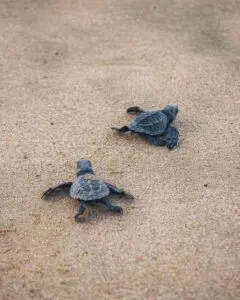WATCH BABY TURTLES ON THEIR FIRST JOURNEY TO THE SEA.
One of nature’s most incredible events happens annually in our region—and you can see it right here at Hilton Los Cabos. From late July to November (especially during August and September) hundreds of Olive Ridley sea turtles will hatch and take their first steps toward the sea.
Turtle Season
In 2003, Hilton Los Cabos cofounded the “Los Cabos Turtle Protection Network,” and we are authorized and certified by the Federal and State Government to train, manage and help to preserve the marine turtle.
We are certified by the Semarnat environment agency to help protect these turtles both before and after they hatch, an accreditation which we earned through continuous training and education. Once eggs are laid in the sand, we patrol a 10-mile stretch of beachfront from El Dorado to El Tule daily to monitor the number of nests, move eggs to our corral if needed, and coordinate the safe release of the babies.
It’s hard work, but if you’ve ever seen these turtles, you know it’s worth it. This is a magical, even spiritual experience, and we hope to share it with you.
Did You Know?
Turtles are found in almost all the world´s oceans except in the Arctic Ocean. There are seven living species of sea turtles, and three inhabit our region: leatherback, hawksbill, and black turtle.
The moment they are born, they head for the Sea; this is the only time in their lives when they are in groups and only a tiny percentage of turtles (.01%) reach adulthood, as many predators, birds, crabs, coyotes, foxes and many more are waiting for them, even the tides, rain and roots of plants can destroy turtle nests.
All marine turtle species are in danger of extinction
Turtles live between 50 and 80 years, swimming at speeds between 16.22 m/h, and they are very, sensitive to the magnetic field of the earth, which they use for navigation and orientation; this is how they return were born to spawn.
In the evening and early morning, adult turtles search for an adequate beach to lay their eggs. After digging the pit, they deposit between 150 and 200 white and very soft-shelled eggs; depending on the hatchling duration of incubation, the temperature determines the sex of the turtles and the higher percentage of female offspring.

How Can I Help?
Join us in our efforts to help preserve the sea turtles. Please adhere to the following rules and guidelines
- It is normal to see adult sea turtles and hatchlings crawling on the beach during the night throughout the year. Report all sightings of both adults and hatchlings to the Hotel Security Guards. They are trained in protecting sea turtles.
- Female Turtles crawl on the beach to look for a good nesting site where they will dig their nests and lay their eggs. Please do not touch, disturb, harass and/or shine lights on them. Although the urge to observe closely will do great, please resist. Nesting is a critical stage in the sea turtle’s life cycle. Report the nesting location to the Hotel Security guard.
- Never handle hatchling sea turtles. If you observe hatchlings wandering away from the ocean or on the beach, report your sightings to the Hotel Security guard.
- Report all stranded (dead or injured) turtles to the Hotel Security Guard.
- Do not throw trash or bags into the ocean.

Frequently Asked Questions
Sea turtles can detect both the angle and intensity of the Earth’s magnetic field, allowing them to determine their latitude and longitude for navigation. They also remember the unique qualities of their natal beach, such as its scent, sounds, magnetic fields, and the features of nearby coastal currents.
The female turtle emerges from the sea at night, searches for a dark and quiet spot on the beach, and begins digging a hole where she deposits between 150 and 200 eggs. She then covers the nest with sand and returns to the sea.
The number of eggs varies by species, but on average, turtles lay around 110 eggs per nest, with 2 to 8 nests per season.
The eggs are similar in shape and size to ping-pong balls with soft shells.
The nest’s temperature determines the gender of the hatchlings. Warmer temperatures produce more females, while cooler temperatures result in a majority of males.
No, once they complete the nest, the females do not return. The eggs and hatchlings must fend for themselves.
Hatchlings stimulate each other to leave the nest as they emerge, increasing their chances of survival against predators.
The difference lies in whether the black turtle is considered a separate species from the green turtle. The debate centers on genetic differences and physical characteristics.
Turtles are phototactic and are attracted to light. They avoid shadows, including dune vegetation on the beach, where danger may lurk.
Each species has a specific diet. Turtles do not have teeth but use jaws or beaks to feed.
Leatherback turtles can dive to depths of more than 1,000 meters, while other species swim in shallower waters.
Turtles can hold their breath for several hours, but a stressed turtle, entangled in a fishing net, can quickly use up its oxygen and may drown in minutes.
The leatherback turtle is the largest and can measure up to 3 meters from tip to tip and weigh up to 970 kg.
No, sea turtles must lay eggs on sandy beaches for them to survive and hatch.
Which is the most threatened sea turtle? The loggerhead turtle is the most common, while the Kemp’s ridley turtle is the most threatened.
Human demand for turtle eggs, meat, skin, and shells, habitat destruction, and pollution pose threats to sea turtles.
Protecting sea turtles is essential for maintaining ecological balance, preserving coastal and marine habitats, and ensuring the survival of numerous species. Moreover, marine and coastal ecosystems are vital for humans, so their protection benefits both










